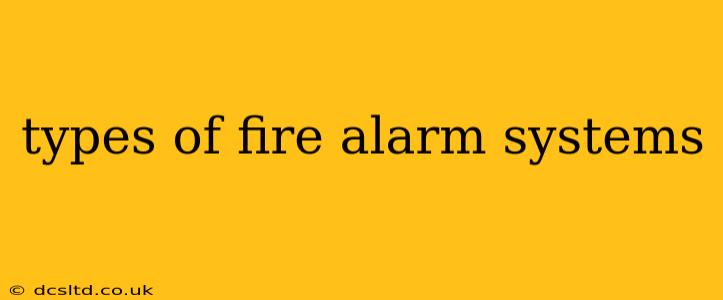Choosing the right fire alarm system is crucial for protecting lives and property. With various types available, understanding their differences is key to making an informed decision. This guide explores the different types of fire alarm systems, their functionalities, and suitability for various applications.
What are the Different Types of Fire Alarm Systems?
Fire alarm systems are broadly categorized based on their detection methods and notification methods. We'll delve into the most common types:
1. Conventional Fire Alarm Systems
These are the most basic and cost-effective systems. They utilize a single circuit to connect all detectors and notification appliances. When a detector senses a fire, it triggers an alarm signal that activates all connected devices. While simple, this design offers limited information about the fire's location. This means everyone is alerted, even if the fire is contained in a single room.
Advantages: Simple, cost-effective, easy to install and maintain.
Disadvantages: Limited location information, potential for false alarms to trigger the entire system, not suitable for large or complex buildings.
2. Addressable Fire Alarm Systems
These systems provide precise location information. Each detector and notification appliance has a unique address, allowing the control panel to pinpoint the exact location of the fire. This enables a more targeted response, reducing unnecessary evacuations and improving efficiency.
Advantages: Precise location identification, improved response times, reduced false alarm disruptions, suitable for large and complex buildings.
Disadvantages: More complex and expensive to install and maintain than conventional systems.
3. Analog Addressable Fire Alarm Systems
This is an advanced type of addressable system. Unlike simple addressable systems that only report activation or non-activation, analog addressable systems provide continuous monitoring of each device. This allows for early detection of issues such as a failing detector or a developing fire before it becomes a major incident. The system can even report the intensity of the fire, offering valuable information to firefighters.
Advantages: Continuous monitoring, early warning detection, provides information on the intensity of the fire, more efficient troubleshooting.
Disadvantages: Most expensive option, complex installation and maintenance.
4. Wireless Fire Alarm Systems
These systems utilize radio frequency (RF) technology to transmit signals between detectors, notification appliances, and the control panel. This eliminates the need for extensive wiring, making them ideal for retrofitting existing buildings or situations where wiring is impractical.
Advantages: Easy installation, cost-effective for retrofits, flexible design.
Disadvantages: Potential for signal interference, battery power requirements, potentially lower reliability compared to hard-wired systems.
What are the Different Types of Fire Detectors?
The choice of fire detectors also significantly impacts the overall system's effectiveness. Common types include:
- Smoke Detectors: Detect the presence of smoke particles in the air. These are further classified as ionization or photoelectric.
- Heat Detectors: Detect a significant rise in temperature. These can be fixed temperature or rate-of-rise.
- Flame Detectors: Detect the infrared or ultraviolet radiation emitted by flames.
- Carbon Monoxide Detectors: Detect the presence of carbon monoxide, a deadly gas produced during incomplete combustion.
What Type of Fire Alarm System is Right for My Needs?
The ideal fire alarm system depends on various factors, including the size and complexity of the building, its occupancy, and local building codes. Consider consulting with a qualified fire protection specialist to assess your needs and determine the most appropriate system for your specific requirements.
How Much Does a Fire Alarm System Cost?
The cost varies greatly depending on the type of system, the size of the building, and the complexity of the installation. Simple conventional systems are the least expensive, while advanced analog addressable systems are the most costly.
How Often Should Fire Alarms Be Tested?
Regular testing is vital for ensuring the system's reliability. Testing frequency varies depending on local regulations and the type of system installed. Consult with your fire alarm installer for specific recommendations on testing schedules. However, monthly visual inspections of all devices are recommended as a minimum.
This comprehensive guide provides a solid foundation for understanding the various types of fire alarm systems available. Remember that seeking professional advice is crucial for ensuring the safety and security of your building and its occupants.
